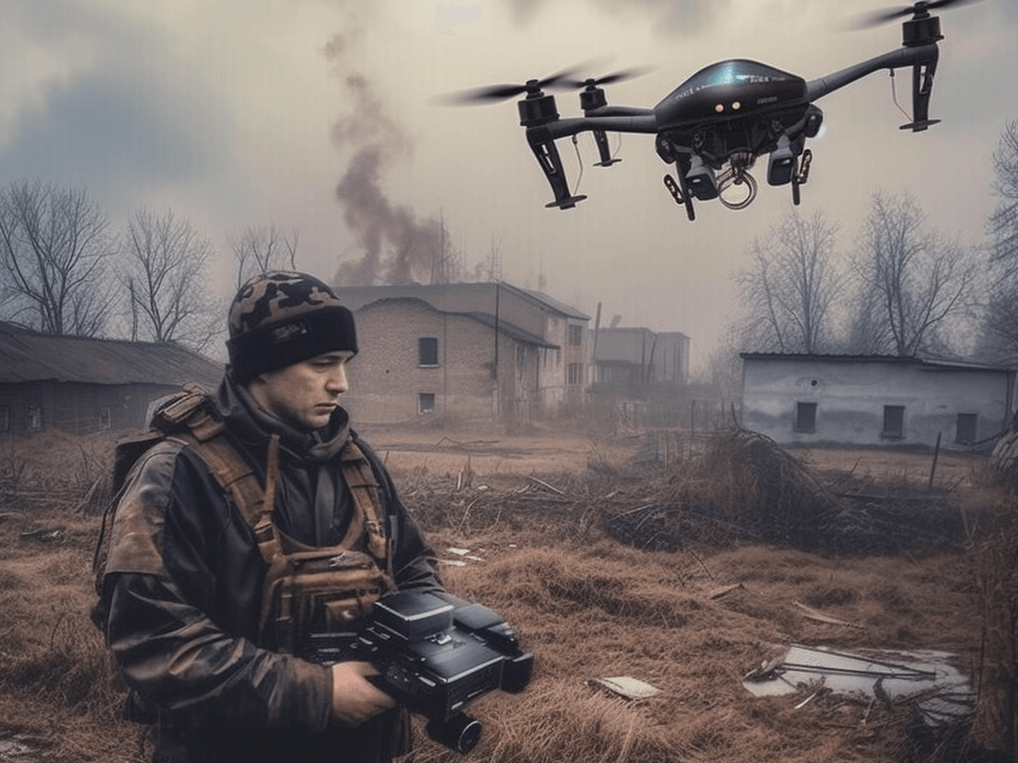The emergence of military drones in modern warfare
General Mark Hertling believes that Ukraine has taken drone technology to a new strategic level. This technology has been around for a while, and unmanned aerial systems, or UAV (Unmanned Aerial Vehicle), have been discussed early on. Since Ukraine lacks manned aircraft, they are heavily investing in drone technology.
Modernkrigföring genomgår en dramatisk förändring genom integrationen av AI och drönare både i luften och till havs.
This represents a modern form of warfare where drones are used to conduct military operations and attacks without having a human pilot on board. Drones can be equipped with different types of weapons and sensors and can be used for reconnaissance, surveillance and carrying out attacks with different types of drones. Even small drones sold in an ordinary store can be turned into a system for aiming artillery fire or shells without much effort.
Här är hur dessa teknologier omformar stridsarenan.
How drones have revolutionized military strategies
The interesting thing is that drone technology is also used in the field of electronic warfare, introducing concepts like "drone swarms." In the future, AI will likely be integrated with drones.
There is a distinction between regular drones and Chinese kamikaze drones that cost around 400 USD. These kamikaze drones move so swiftly that they cannot be shot down and are designed for a single mission. A new type of drone will likely emerge in the future.
cruise missile drone.
Kamikaze drones are often smaller and cheaper than cruise missiles. They are also more maneuverable, allowing them to attack targets that are difficult to reach with a cruise missile. Additionally, kamikaze drones can return to base if they do not find a target, saving money on munitions.
Cruise missile drones have a longer range than kamikaze drones. They are also more precise, allowing them to be used for attacking targets that are sensitive to damage. Additionally, cruise missiles can be equipped with various types of weapons, including nuclear ones.
Stealth drones have several advantages that can enhance tactical operations. They are difficult to detect by enemy radar, allowing them to be used for gathering information or attacking targets without being noticed. Stealth drones are also highly maneuverable, enabling them to operate in tight spaces or evade enemy fire. Additionally, stealth drones can be equipped with a variety of sensors and weapons, making them suitable for a wide range of tasks.
Svärmkrigföring: Att utnyttja potentialen hos drönarsvärmar i luften och slagfältet
Swarm warfare is a type of warfare that utilizes large swarms of small, inexpensive aircraft or drones to overwhelm the enemy. The swarm can consist of hundreds or even thousands of drones, all equipped with simple sensors and weapons. The drones can be centrally controlled or they can be autonomous, and they can be used to perform a variety of tasks, such as gathering information, attacking targets, or disrupting enemy communications.
Drönarsystem i luften:
- Autonoma svärmar som kan överväldigade traditionella luftförsvarssystem
- Stealth-drönare för djup penetration av fientligt luftrum utan att riskera piloter
- ”Loyal wingman”-koncept där bemannade flygplan som F-47 samarbetar med billigare, förbrukningsbara drönare
- Konstant övervakning över stridsfältet med permanent ISR (Intelligence, Surveillance, Reconnaissance)
Swarm warfare has the potential to revolutionize warfare. Swarms of drones can be very difficult for the enemy to defend against, and they can be used to attack targets in ways that are impossible for human pilots. Additionally, swarms of drones are very cost-effective, making them an economical way to wage war.
Marina drönarsystem:
- Autonoma ubåtar och ytfartyg för långvarig övervakning av sjövägar
- Undervattensdrönare som kan upptäcka och neutralisera minor eller attackera fientliga fartyg
- Drönarsvärmar som kan störa marina kommunikationssystem och navigationsutrustning
Different types of military drones
CLASS I Microdrones (eng. microdrones) weighing less than 150 kg can be used for various purposes such as intelligence, surveillance, and reconnaissance (ISR), target acquisition, communication relay, battlefield damage assessment, or for delivering ammunition. An example is the Micro Raven produced by AeroVironment. It can be carried in a backpack and fly for 1.5 hours and is used for reconnaissance.
It uses an infrared camera and GPS receiver.
CLASS II Minidrones (eng. minidrones) weighing between 150 kg and 600 kg are used for the same purposes as microdrones, but can also be employed in more complex missions such as suppressing enemy air defenses (SEAD), electronic warfare (EW), or even for combat operations. An example is the SkyRanger, which is equipped with a high-resolution camera.
CLASS III Small drones, weighing more than 600 kg, represent the largest and heaviest class in this category and are used, just like other drones, for ISTAR (Intelligence, Surveillance, Target Acquisition, and Reconnaissance). They can also be used for electronic warfare, air traffic control on the battlefield, combat missions, convoy protection, and even as decoys. For example, the MQ-X produced by General Atomics can be equipped with various weapon systems such as Hellfire missiles.
Vad vet vi om F-47 – amerikas senaste vapensystem
F-47 är USA nästa generations stridsflygplan inom ramen för Next Generation Air Dominance (NGAD)-programmet. Varje flygplan beräknas kosta omkring 300 miljoner dollar, även om tidigare flygvapenministern Kendall eftersträvade en kostnad på 80-100 miljoner dollar.
F-47 är tänkt att fungera som en ”quarterback” (spelledare) för ett nätverk av drönare:
- F-47 kommer att vara centralt i ett system där bemannade flygplan samarbetar med flera autonoma drönare
- Dessa drönare kallas Collaborative Combat Aircraft (CCA) eller ”loyal wingmen”
- Anduril Industries och General Atomics utvecklar de autonoma drönarna som ska stödja F-47
- Systemet innebär att piloten i F-47 kan kontrollera eller dirigera flera drönare samtidigt
- Drönarna kan utföra farliga uppdrag som målsökning, störning av fientligt luftförsvar, attackuppdrag eller fungera som sensornoder
- Detta minskar risken för den mänskliga piloten samtidigt som systemets totala förmåga ökar
- Drönarna kan offras om nödvändigt medan det dyrare bemannade flygplanet håller sig på säkert avstånd
- Hela systemet är sammankopplat genom avancerade nätverkssystem, sensorer, och elektronisk krigföring
- En obemannad version av NGAD planeras också i framtiden
- Drönarna utvecklas av Anduril Industries och General Atomics
Detta koncept representerar ett fundamentalt skifte i luftstridsförmåga, där ett enda bemannat flygplan fungerar som en nod i ett större, delvis autonomt system snarare än som en enskild plattform.
Russian drones
Here we see a Russian FPV drone in the war against Ukraine. An FPV drone is a type of drone used for FPV flying, which stands for 'First Person View.' When flying an FPV drone, the pilot sees what the drone sees in real time, usually through specially designed video goggles or via a screen. This provides an experience similar to sitting in the cockpit of the drone.
https://www.facebook.com/winston.frank.5680/videos/1460728958118538/?idorvanity=1549230588572330
Drones from Ukraine
Ukraine purchased drones from Turkey early on. Today, they have a minister with the title of digital transformation and have organized a drone competition in the country to determine the best use of various types of drones. The goal is to identify a startup and scale up the operation.
They have also used maritime drones, which have proven effective against Russia's Black Sea fleet, causing them to regroup from Sevastopol.
What are the benefits of drone warfare?
One of the main advantages of drone warfare is that drones can operate at great distances from their bases, thus reducing the risk of human casualties. They can also stay in the air longer than manned aircraft and provide continuous surveillance and support to troops on the ground.
Drone warfare also has the potential to reduce the cost of warfare by avoiding the need to train and maintain manned aircrew. In addition, drones can be smaller and more elusive than traditional aircraft and can therefore perform missions with a lower risk of detection and shooting down.
At the same time, drone warfare has raised some controversies and ethical questions. Critics worry about the lack of direct human decision-making in attacks, stressing that it can be difficult to ensure sufficient precision and to minimize civilian casualties. There are also concerns that drone strikes could undermine international law and sovereignty when used outside recognized conflict areas.
Drone warfare has become increasingly widespread and is used by several countries around the world and countries that have come a long way in manufacturing are Turkey and Iran.
AI i militär teknik
AI har utvecklats i en rasande takt under 2024 och 2025 så det är naturligt om de utrustas med AI.
Drönare har blivit ett betydande inslag i modern krigföring och fortsätter att utvecklas med nya teknologier och förmågor som artificiell intelligens.
AI-driven beslutsfattande:
- Snabbare analys av stridsfältet och beslutsfattande än mänskliga operatörer
- Förmåga att koordinera komplexa attacker med flera system samtidigt
- Avancerad målidentifiering och prioritering med minimal mänsklig inblandning
How can we in Sweden protect ourselves against drones in future conflicts?
Protecting against remote-controlled drones such as FPV (First-Person View) and Shahed drones is a complex and multi-dimensional challenge that requires both technical and strategic measures.
Krigsföringens förändrade natur:
- Minskad mänsklig närvaro på stridsfältet minskar egna förluster
- Ökat tempo i operationer när AI-system kan fatta beslut på millisekunder
- Suddiga gränser mellan fred och krig genom möjligheten till konstant ”grey zone”-aktivitet med drönare
- Ökad risk för eskalering när tröskeln för att använda autonoma system kan vara lägre
Maybe the Home Guard will guard protective objects when the opponent has FPV drones and Shaheder? Many new weapons are likely to be needed in combination with AI: modern air defense systems, electronic warfare, networks of sensors and surveillance systems, cameras and radars that track drones, physical obstacles, specialized defense systems.
För länder som Sverige innebär detta att framtida försvarsinvesteringar måste inkludera både offensiva och defensiva AI- och drönarsystem. Det räcker inte längre med traditionella vapensystem när motståndare kan använda massiva drönarkampanjer som kan överväldigda konventionella försvarssystem.
Here are some of the most effective methods:
Anti-aircraft system: Modern anti-aircraft systems can detect, track and neutralize drones. These systems use radar and other sensors to identify threats and can then fire missiles or use directed energy weapons to destroy the drones.
Electronic Warfare: This means jamming or taking over the drones' communication systems. By jamming the signals, one can prevent the drone from receiving instructions from its operator, rendering it inoperable or even possible to take over.
Scientists and engineers have proposed a number of ideas. One of the most promising is a directed energy weapon that uses lasers and microwaves to disable or destroy enemy drones. The advantage of such systems is that they have no limitations on the amount of ammunition, as they are limited only by the energy supply. In addition, the developers of such weapons themselves state that the price of such a shot is much lower, while current air defense systems use expensive missiles and are not so fast. In the USA, Raytheon has been commissioned to create an air defense system against drones, which will be based on microwave radiation according to a Ukrainian source.
Network of sensors and monitoring systems: Using a network of sensors, including radar and cameras, drones can be detected and tracked. These systems can be stationary or mobile to provide comprehensive protection.
There are several high-tech drone detection tools that can be used to protect a building or area from unwanted drones:
- IRIS® Micro-Doppler radar: IRIS® is a countermeasure UAS (Unmanned Aerial System) micro-Doppler radar that offers 360-degree azimuth and 60-degree elevation surveillance, providing early warning of approaching drones from all directions in full 3D. This technology detects speed differences within moving objects, such as a drone's rotor. Is very effective in detecting drones in all directions and provides early warning. The price of such advanced radar equipment can be quite high, often in the tens of thousands of dollars, but exact prices vary by specification and supplier.
Supplier: Robin Radar Systems. They specialize in radar solutions for tracking small objects such as birds and drones. - Aerial Armor Drone Detection Software: This software integrates with multiple RF sensors, radars and ADS-B to provide advanced and layered security solutions to protect against unwanted drones. The software is adapted for use in various facilities, including airports. Efficiency increases with the use of multiple sensors. The cost of such integrated systems can vary widely and are often priced based on customization to the customer's needs. Supplier: Aerial Armor.
- RF drone detection: RF detection uses radio sensors that passively listen and monitor frequencies from 70 MHz to 6 GHz for transmissions on the communication link between the drone and the pilot. This can be used to determine the position of the drone and sometimes also the pilot. This type of technology can be more affordable compared to complex radar solutions, but exact prices depend on the manufacturer and the scale of the system. Several companies offer RF detection technologies. Some examples are Dedrone and DroneShield.
- Drone Detection with Radar: High resolution radar specifically designed for drone detection and tracking. The radars continuously scan the sky looking for reflections and changes to detect movement and size. Reflected signals can be compared to a drone characterization database, improving detection performance and reducing false positives. This type of radar can be expensive, especially for models with high resolution and advanced features. Companies such as Robin Radar Systems and SRC Inc. offer radar-based drone detection systems.
- Visual Tracking: PTZ (Pan-Tilt-Zoom) cameras can be used in conjunction with other drone detection technology to create and relay a visual record of a drone incident. Drone detection software usually directs a PTZ camera with the GPS position of the drone, allowing the camera to pan, tilt and zoom in on the right area to capture a visual image of the drone.. The cost of PTZ cameras varies depending on quality and features, but they are generally cheaper than radar-based systems. Companies such as Bosch, Axis Communications and Hikvision are well-known manufacturers of PTZ cameras that can be used in drone detection systems
- DedroneTracker.AI: This platform integrates multiple systems into a single interface, which is a comprehensive airspace security solution that can be used for early drone detection, accurate drone identification and precise flight path tracking. As an integrated platform, its efficiency can be very high, but the cost depends on how many and what types of integrated systems are used. Supplier: Dedrone. They offer an integrated platform system for airspace security and drone detection.
Protection of critical infrastructures: Specific protective measures can be taken to protect important infrastructure such as power plants, military installations and government buildings. These include physical barriers, such as nets, and specialized defense systems. Even larger high-rise buildings where many people live need protection against drone attacks.
Training and Tactics: Military personnel need to be trained in identifying and dealing with threats from drones, but the technology also needs to be integrated in the units. This includes both operational and tactical training to effectively respond to threats.
International cooperation and intelligence work: Cooperation with other countries to share information and experience on drone threats and defense strategies is essential. This could include sharing intelligence on drone operations.
Defense against drones requires a combination of these methods to be effective. Each method has its own strengths and weaknesses, and a multifaceted approach is essential to effectively deal with these threats.
Which countries are famous for their drones?
USA
Has over 100 different types of military drones. Read more. Among major brands are Reaper drones and predator drones from General Atomics. The Reaper drone has been used to conduct high-level strikes and gather valuable intelligence.
China
AVIC Cloud Shadow
China has been actively exporting armed drones, and over half a dozen states now use Chinese drones capable of carrying out combat missions. During the Winter Olympics opening, they also demonstrated that they have the capacity to handle drone swarms.
Europe
In Europe, Airbus, Dassault Aviation and Leonardo have joined forces to develop a MALE drone system, known as Eurodrone. Swedish SAAB has also been involved in Dassault nEUROn the project.
Turkey
TB2 Bayraktar, Bayraktar Akinci, Kızılelma will be launched
Iran
The Shahed 191 carries two Sadid-1 missiles internally and lands on retractable landing skids. Shahed 191 has a cruising speed of 300 km/h, an endurance of 4.5 hours, a range of 450 km and a payload of 50 kg.
Israel
There are 26 different drones. Read more




